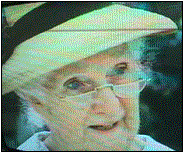
Video Rising, 13(2), 3-6, 2001.
|
Some Ideas for Using Movie Openings* Johanna E. Katchen |
I’ve always tried to avoid showing a whole film in class. I prefer using short clips for more intensive language practice and feel my students can watch the whole film outside of class if they are interested, even though they read the L1 subtitles. That way, if they have little interest in the film, we haven’t wasted their valuable class time.
One part of a film that can be especially fruitful for teaching is the opening or introduction. Just like with a good piece of writing, the first few minutes have to get our attention and interest and in some way narrow down the topic. The characters are shown to behave in a way that indicates their later development. The scene is set (e.g. 16th century London rather than 21st century Sahara Desert) and so are the tone and genre (comedy, epic, etc.). Often the opening occurs along with the opening credits, and this can be distracting in some cases. At other times, the real opening may be the first scene after the credits.
One characteristic of many film openings is the flashback. We see an old person thinking back to her younger days, or a grown man reminiscing about his boyhood, or some variation thereof. The Joy Luck Club begins its opening credits with a narration by one of the daughters telling of her mother’s journey from China to the USA with a swan. It continues: (from The Joy Luck Club)
| "But when she arrived in the new country, the immigration officials pulled the swan away from her, leaving the woman fluttering her arms and with only one swan feather for a memory. For a long time now, the woman had wanted to give her daughter the single swan feather and tell her, ‘This feather may look worthless, but it comes from afar and carries with it all my good intentions." |
This short narration serves to frame the misunderstanding between the older the younger generation, between Chinese and American ways, illustrated in the story. The film then begins its action in the present.
The Remains of the Day also begins with a narration, with the main character, Mr. Stephens, reading a letter from the former housekeeper. The letter is written at the present time, with the writer remembering the past and also giving more recent news. The reminiscing in the letter causes Mr. Stephens to think back to when he first met the housekeeper, and provides the reason/connection for the story to switch to the past.
These opening narrations discussing past events are ideal for finding examples of the use of past, present perfect, and past perfect tenses in the same text. Take a look at the opening of The Remains of the Day below. The tense forms are in bold. With students, we can leave a blank and just provide the basic verb form (in parentheses). Students have to decide which tense to use and to defend their choice. Then they watch the scene and note the tenses used in the film version and discuss whether and why their version differs from the film version (sometimes more than one option is possible).
From the Opening of The Remains of the Day
|
Dear Mr. Stephens, You WILL (be) surprised to hear from me after all this time. You HAVE BEEN (be) in my thoughts ever since I HEARD (hear) that Lord Darlington HAD DIED (die). We READ (read) in The Manchester Guardian that his heirs PUT (put) Darlington Hall up for sale because they no longer WISHED (wish) to maintain it. The article WENT (go) on to say that since there WERE (be) no buyers for such a large house, the new earl HAD DECIDED (decide) to demolish it and sell the stone to a local builder for five thousand pounds. We also SAW (see) some rubbish in The Daily Mail which MADE (make) my blood boil. Tracers Nest is to be pulled down. |
To Elicit Language—Description and Prediction
Movie beginnings are also good for prediction activities. If the students have seen the film (as with most popular films), they already know what will happen, but it may still be useful for them to talk about the film and what will happen in English rather than in their L1.
Other than Hollywood blockbusters, there are other obscure films, old films, films made for TV that students probably have not seen. Many film openings set the scene for what is to come, and students can be asked to speculate on how the film will develop. Even foreign films can be used for this purpose, with or without sound, forcing students to pay attention to body language and other details.
My own interest in British murder mysteries prompted me to choose the Agatha Christie story A Caribbean Mystery (1989, BBC; 1994, A&E; 100 minutes) about seven years ago for some classroom activities, including prediction. This particular film is unique because during the first five minutes, each of the eleven main characters is shown behaving in a typical way. All are staying at a Caribbean resort; it is mid-morning. After asking a few warm-up questions, I give students a list of the eleven characters in the order they will appear and ask students to write down some descriptions of each character as they watch the opening. They usually describe Lucky Dyson as sexy, fashionable, and liking men, whereas Miss Marple is seen as an old busybody who looks bored.
The first few times I used this activity, I gave just the names of the characters and I found that students had difficulty matching each of the characters with the names. After I got a digital camera, I added the photos of each character by freeze framing them on the TV and taking a photo of the TV screen. Then I just added them to the Word file handout using the command Insert Picture and Word’s picture editor to resize and crop each image. This change made the handout more attractive and the characters easier to keep track of.
After students discuss and describe each character, I show the next scene, with the same characters that evening having dinner. In this scene a few more relevant details emerge. Then I ask students to discuss (if there is class time) or to write a paragraph for homework based on three questions: 1. Who will be murdered? 2. Who will be the murderer? 3. What will be the reason for the murder? The activity is usually a lot of fun, because there are many possibilities and some students are very perceptive. During the next class, I play the next part, where we find out who is murdered, but not by whom and why. I don’t reveal the answer but leave a copy of the film in the self-access lab for students to watch and find out on their own time.
Do you like murder mysteries? Do you read these kinds of novels? Or watch them on TV? Which ones?
Describe the heroes of these stories? Who are they?
Have you ever read any of the stories of Agatha Christie? Which ones?
Describe the Characters
As you watch the opening scene of this film, you will see each of the following characters appear in this order. Write down some of your ideas about each character.

________________________________________
________________________________________

_______________________________________
_______________________________________
[Handout continues with photos/descriptions for the nine other main characters. Photos can be made by freeze-framing your TV, taking photos of the screen on a digital camera, then downloading the images into your handout.]
Discussion
Now, with the person(s) next to you, share your ideas about the kind of person you think each of these characters is.
Tonight there will be a murder. Your job is to decide—
1) Who will be murdered? ____________________________________________
2) Who will be the murderer?____________________________________________
3) What will be the reason for the murder? _________________________________
Discuss this with the person(s) next to you (or write down this information in one paragraph or more for homework).
*The idea for this article came from Nick Flynn (ESADE, Spain), who gave a workshop presentation called “Opening Scenes” at the 1997 IATEFL Conference in Brighton. To date, he has not published his ideas. The activity from The Remains of the Day is from Flynn.